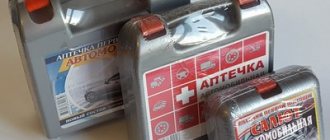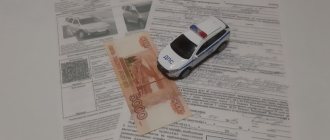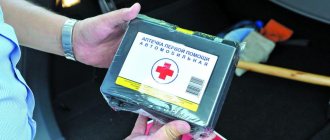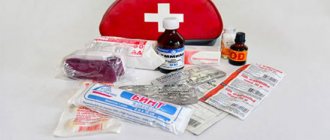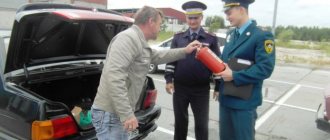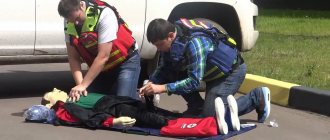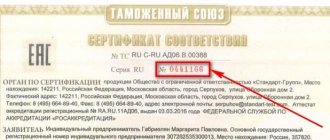Drivers of which vehicles are required to carry a first aid kit?
Russian traffic regulations contain an appendix that lists the conditions under which the operation of vehicles is prohibited in our country. One of these conditions is the lack of a first aid kit on most types of transport.
According to the appendix to the traffic rules, a first aid kit is required for:
- buses,
- passenger cars,
- trucks,
- wheeled tractors,
- motorcycles with side trailers.
Thus, for example, a first aid kit is not required for motorcycles without a sidecar (“sidecar”).
A ban on operating the listed vehicles without a first aid kit does not mean a ban on movement. Of course, if a situation arises in which you have to use part of the contents of the first aid kit, you should not look for where to buy a new first aid kit or look for an opportunity to restock it, and only then move on. You can drive further, but at the first opportunity you need to purchase either a new first aid kit or that part of its contents that is missing.
What are the standards?
In Russia, there are rules for completing a car first aid kit; with its help you can stop the bleeding and bandage a wound, as well as perform artificial respiration. Some medications were excluded, as well as brilliant green and iodine.
Health Ministry officials say that in the event of an accident, first aid to victims is provided by people without medical education. They cannot correctly determine the indications and contraindications for the use of drugs in a particular case. Apply a tourniquet, fix the fracture, stop the bleeding - not everyone can do this. If you provide medical care incorrectly, you can end up in prison.
When were the last changes made to the composition of the car first aid kit?
The composition of a car first aid kit, which is mandatory in 2021, was approved back in 2009, and the changes came into force at the beginning of 2010. Since then, nothing has changed; the composition of the first aid kit remains the same for the ninth year in a row.
The changes that were made to the first aid kit in 2009 were very noticeable. In a modern car first aid kit there are virtually no medications in the form of drugs, especially painkillers.
A modern first aid kit is mainly tools for dressing wounds and stopping bleeding, as well as for carrying out resuscitation actions that are accessible to a non-specialist.
There are several reasons why painkillers were removed from the first aid kit. One of the main ones is the victim’s possible allergies, due to which painkillers will only worsen his condition. Another reason is that it is impossible to provide some specific storage conditions for such medications in a car.
What is a car first aid kit
A car first aid kit according to GOST is a specific set of medications, a list of which was compiled and approved by order of the Ministry of Health. Every Russian driver is required to keep such a suitcase with a red cross on the lid, sold in specialized auto stores and regular pharmacies, in his car. The availability of the recommended emergency kit and its completeness can be checked by a traffic police officer.
A car first aid kit can also be called a personal bag or box of medicines that a motorist considers necessary to carry with him. But this will only be considered an addition to the strictly prescribed list that is required by law.
Composition of a car first aid kit in 2021
The composition of a first aid kit for motorists is regulated by the Order of the Ministry of Health (in 1996, when the order was drawn up, the ministry was called the Ministry of Health and Medical Industry) in its current version.
In total, the first aid kit should contain 17 different items (including the case and instructions):
- Hemostatic tourniquet - 1 pc.
- Non-sterile bandages 5 m x 5 cm - 2 pcs.
- Non-sterile bandages 5 m x 10 cm - 2 pcs.
- Non-sterile bandages - 7 m x 14 cm - 1 pc.
- Sterile bandages 5 m x 7 cm - 2 pcs.
- Sterile bandages 5 m x 10 cm - 2 pcs.
- Sterile bandages 7 m x 14 cm - 1 pc.
- Sterile dressing bag - 1 pc.
- Sterile medical gauze wipes (minimum 16x14 cm) - 1 pack.
- Bactericidal adhesive plasters (minimum 4x10 cm) - 2 pcs.
- Bactericidal adhesive plasters (minimum 1.9x7.2 cm) - 10 pcs.
- Rolled adhesive plaster (minimum 1 cm x 2.5 m) - 1 pc.
- Device for resuscitation “mouth-device-mouth” - 1 pc.
- Scissors - 1 pair.
- Medical gloves (minimum size M) - 1 pair.
- Recommendations for using a first aid kit - 1 copy.
- Case for first aid kit - 1 pc.
Theoretically, you are not required to buy a ready-made first aid kit. You can assemble it yourself.
Of course, it’s easier to buy a ready-made kit, but you can complete the first aid kit yourself. The main thing is not to forget to find and print (or, alternatively, make a photocopy) recommendations for using a first aid kit and put first aid supplies in the case. Both of these elements must be present.
Car first aid kit 2021: composition according to GOST
The current contents of a car first aid kit were adopted back in 2010, when the composition of a medical bag for a car was significantly revised by the Ministry of Health and Social Development. As a result, all drugs such as validol, activated carbon and nitroglycerin were excluded from it. Instead, hemostatic agents are now required to be stored in the travel first aid kit. Doctors believed that motorists with chronic diseases always have the necessary medications with them in any case. And the use of drugs from the list of old-style medications to help victims of road accidents is impractical and even dangerous. Participants in an accident who do not have a medical education often do not know how to use medications correctly; a number of drugs can cause allergic reactions, and painkillers make it difficult for doctors to make a diagnosis. The worst thing is that the constant presence of medications in the car does not comply with their storage conditions.
At the same time, a significant part of the victims die due to blood loss, so the main requirement of the current GOST for first-aid kits is dressing materials. cardiopulmonary resuscitation equipment as a mandatory part of the emergency travel kit.
Expiration date of a medical first aid kit 2021
Even from the composition of the first aid kit, it is obvious that it has a long shelf life. Since there are no medications in a modern car first aid kit, its shelf life is limited only by the shelf life of adhesive plasters, which lose their quality over time.
However, the first aid kit has a general shelf life of 4.5 years.
You are allowed to use the first aid kit for another six months, but during these six additional months it must be replaced with a new one.
Shelf life of a new car first aid kit
The expiration date of a car first aid kit has not changed for 8 years, 2019 – 2021 were no exception.
Previously, the case contained several medications, each with its own expiration date. After the changes in 2010, the first aid kit legally began to serve for 5 years. What does this interval include? 4.5 years is the shelf life of the first aid kit itself . After this period, you are given six months to change medications. Do you want to know in time about the need to change your first aid kit? Take a look at the case markings located on the front side.
Due to one or more spoiled medications, there is no need to buy a new first aid kit as a whole; it is enough to replace individual elements. For example, if the plasters and bandages are not in good shape (the integrity of the packaging has been damaged, the markings have been erased), go to the nearest pharmacy and buy new ones. The shortest shelf life in the updated list is for plasters and tourniquets.
Punishment for not having a first aid kit in 2021
Article 12.5 of the Code of Administrative Offenses of Russia establishes two possible types of punishment for the lack of a first aid kit: a warning or a fine of 500 rubles.
Considering that a new first aid kit costs on average 300-500 rubles, there is no point in risking a fine and abandoning it. Moreover, it may turn out that you are risking not only a fine, but also someone’s life. Perhaps your own.
Moreover, the following circumstance should be kept in mind. The Russian Criminal Code has articles 124 and 125, which provide penalties for failure to provide assistance to a patient and leaving a person in danger. If a situation occurs in which you were supposed to help someone, but were unable to do so because you did not have a first aid kit, you may well be charged with a criminal offense. And this is no longer a 500 ruble fine, but fines of tens of thousands of rubles, forced labor or even imprisonment for up to one year.
Equipment according to GOST
The decision to reduce the contents of the car first aid kit was made in 2009. Medicines used for problems with the cardiovascular system and painkillers were removed from its composition. Drugs for pulmonary-cardiac resuscitation (not in the form of tablets) have been introduced, and the list of drugs (mainly bandages/tourniquets/plasters) for stopping bleeding has been expanded.
Strictly speaking, the composition of a first aid kit for a car is approved by the Ministry of Health of the Russian Federation. Previously, it contained almost all medications related to basic ones, that is, those that made it possible to provide first aid for most types of injuries received as a result of an accident and in the event of pathological conditions occurring in the driver and passengers while driving in a car.
According to the order of the Ministry of Health of the Russian Federation No. 697, which came into force in 2010, the following were removed from the car first aid kit:
- validol (a medicine with a vasodilator effect, used when pain occurs in the area of the heart muscle);
- aspirin (a common and cheap broad-spectrum analgesic);
- brilliant green;
- nitroglycerin (a powerful vasodilator used to treat angina attacks);
- activated carbon (a remedy used for all types of poisoning and gastrointestinal disorders);
- ammonia;
- analgin (another representative of the group of analgesics).
At the same time, the presence of dressing materials was increased.
What guided those who made the decision about what should be in a car first aid kit? The arguments presented in the media look convincing to some, and far-fetched to others. But the fact remains that the situation is similar in neighboring countries. Moreover, in most European countries, medications have been excluded from the first aid kit for quite a long time.
Here are the arguments in favor of radically reducing the contents of the first aid kit:
- since first aid to the injured and sick is provided by the driver or passengers who do not have a medical education and in most cases do not have the appropriate skills, the uncontrolled use of medications is fraught not with improvement, but with a deterioration in the condition of the patient/injured;
- the increase in the composition and quantity of dressings is due to the specific nature of injuries sustained in road accidents: bleeding is considered the main negative factor. Therefore, stopping him when receiving one or more wounds now became a priority;
- one of the factors that determined the exclusion of medications is considered to be the inappropriate temperature regime in a vehicle for their long-term storage, since the temperature even during one trip can fluctuate within a fairly wide range, and more than once, which is unacceptable for most medications;
- the exclusion of tablets made it possible to triple the shelf life of the first aid kit as a whole, the same applies to most of its current components;
- the driver has the right, at his own discretion, to supplement the first aid kit with those drugs that he considers vital (for example, prescribed by a doctor or taken independently);
- the emergence of a large amount of dressing material while improving the quality of preparation of car owners to provide first aid to victims will reduce mortality in road accidents, reducing the severity of the consequences of accidents involving vehicles;
- those medications that were mandatory previously are not considered vital when providing first aid to those injured in an accident, that is, they do not have any noticeable effect on the mortality rate as a result of an accident.
From the above it follows that the previously present list of medications in the car first aid kit did not help stop bleeding, which, according to statistics, is the primary factor in increasing mortality in accidents. That is why the emphasis was placed on bandages, tourniquets, plasters and other means to quickly stop bleeding by unskilled people.
The requirements for a 2021 car first aid kit include several types of medical adhesive plasters, bandages, a tourniquet, a device for self-performing artificial respiration, gloves, scissors, and a package of sterile wipes. In total, this list includes fifteen items.
Each component of a car first aid kit is produced in accordance with a specific GOST; for the current composition, the main regulatory documents are GOST 117993 and GOST R ISO 1099399.
So, what exactly is included in the current car first aid kit in 2021:
| Name | Quantity, pcs. | Size, cm | GOST | |
| Device for pulmonary-cardiac resuscitation in case of respiratory arrest and absence of cardiac arrest | 1 | GOST R ISO 1099399 | ||
| Means for the rapid stop of bleeding | ||||
| Hemostatic tourniquet | 1 | GOST R ISO 1099399 | ||
| Sterile gauze pads | 1 package | 14x16 or more | GOST 117993 | |
| Non-sterile gauze bandage | 2 | 500x5 | GOST 117993 | |
| Sterile gauze bandage | 2 | 500x5 | GOST 117993 | |
| Non-sterile gauze bandage | 2 | 500x10 | GOST 117993 | |
| Sterile gauze bandage | 2 | 500x10 | GOST 117993 | |
| Non-sterile gauze bandage | 1 | 700x14 | GOST 117993 | |
| Sterile gauze bandage | 1 | 700x14 | GOST 117993 | |
| Sterile dressing bag | 1 | GOST 117993 | ||
| Germicidal adhesive plaster | 2 | 10x4 or more | GOST 117993 | |
| Germicidal adhesive plaster | 10 | 7.2x1.9 or more | GOST 117993 | |
| Tape type adhesive plaster | 1 | 250x1 | GOST R ISO 1099399 | |
| Other medical supplies | ||||
| Scissors | 1 | GOST R 5126899 | ||
| Medical gloves | 1 package | M1 or more | GOST R ISO 1099399 | |
In addition, the first aid kit comes with instructions for using the products included in it.
Let us note that many motorists consider the composition of a car first aid kit to be unbalanced, if only due to the lack of disinfectants (the same green stuff or hydrogen peroxide). Many doctors are of the same opinion.
There are also complaints about the quality of individual components. So, the scissors in the first aid kit are too flimsy: if you try to cut clothes with them to get to the wound, they are more likely to bend than fulfill their mission, and the life of the victim may depend on this. The same applies to a tourniquet: it is too thin to stop bleeding, for example, in the thigh area. Moreover, even if you use a bunch of several such tourniquets, the likelihood that they will break remains quite high.
But we have what we have: the equipment of a car first aid kit in Russia is considered balanced and, for the most part, brought into line with European standards.
